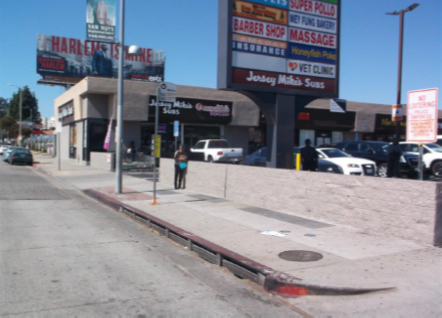
Finalist: Climate Change Adaptation
Heat equity analysis for bus shelter provision
Los Angeles, US
The Challenge
In the sweltering city of Los Angeles, less than one in four bus stops includes a shelter and most of these are in areas with mostly low-income and BIPOC households who are dependent on public transport. With temperatures becoming more extreme due to climate change, residents are at risk of sunburn, heat exhaustion, dehydration and sunstroke.
The Innovative Project
Rather than focusing solely on geography, a survey was conducted in the Sun Valley area of Los Angeles targeted at residents by income, ethnicity and race to reach those most affected. Over 190 citizens responded to explain their needs and help the city of Los Angeles improve bus stop provision.
“We really need benches and of course a shelter. There are so many babies, kids, disabled and older people waiting outside under the hot temperatures everyday.”
Bus shelters that include benches, hydration stations, shelter and even mobile phone charging points are now being piloted. Additional ideas included shade coverings at different angles to provide shade at all times of the day, cool-to-the-touch seating, a digital bus map, real-time arrival information, a call-button to contact someone for help or for security reasons, solar-powered lighting, a trash receptacle, hand sanitizer dispensers, a hydration station, a place to charge personal electronic devices, and materials like photocatalytic titanium dioxide that filter local air pollution. All of these potential improvements could help attract new riders and retain existing ones by making bus service a higher-quality, more dignified experience, while protecting the health and safety of riders across Southern California. 3,000 shelters will be built across Los Angeles in the next five years.
The Partnership
Grassroots environmental justice organisation Pacoima Beautiful and the South Los Angeles Transit Empowerment Zone (Slate-Z) engaged with community members about the features and locations of bus shelters, and also connected with business owners about their fear of the homeless using bus shelters as encampments.
In preparation for a new and updated Sidewalk and Transit Amenities Program (STAP), StreetsLA gave the general public the opportunity to see and give feedback on proposed new bus shelters and technology features. Public demonstrations were held from the top two potential contractors in July 2021 where citizens gave feedback on what features they would like to see at the updated bus shelters. StreetsLA used this feedback to negotiate with the winning contractor, Climate Resolve, on the features to incorporate into the next generation of bus shelters so that the City of Los Angeles has shelters that are customized and designed to the needs of Angelinos.
The Impact
Informed by the findings of the equity survey, the city has now established a Transit Oriented Communities (TOC) policy, which aims to preserve affordability near transit. The policy will set direction for how Metro plans and implements new and existing transit corridor projects, for supporting land use and community development around existing transit corridors, and for encouraging and incentivizing partners to pursue the same goals, such as increasing ridership, stabilizing and enhancing communities that surround transit areas, distributing transit benefits fairly to all citizens, and capturing value created by transit.



